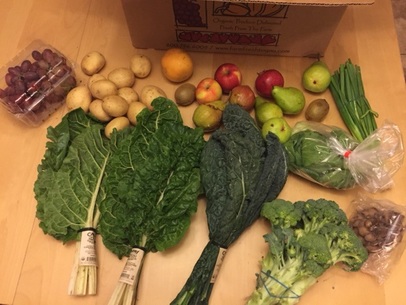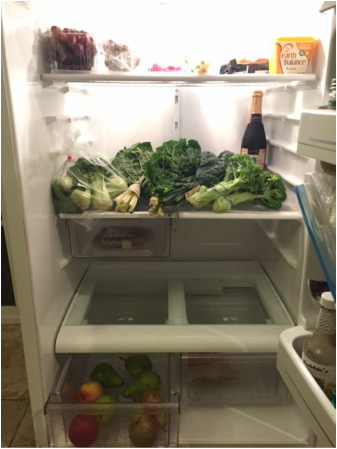 They say the crisper is where good intentions go to die, because everyone buys fresh fruits and vegetables and leaves them there until they turn into compost. Well, I used to hide dirty dishes in my crisper. It seemed like a good plan, since it would only hold a couple of small plates and bowls. If my boyfriend was headed to my apartment, and I only had enough time to do a couple of things to get ready, that was the easiest way to preserve the illusion that I was the terrific housekeeper I am today. Now I understand that it would have been faster to just wash them. I also understand that a crisper is an “attractive nuisance” that is the worst possible design for encouraging healthy eating. The empty fridge you see at the beginning of this post is ours. Don’t worry, we’re fine. It’s just the day before the CSA box was due. (That’s Community Supported Agriculture, as I will explain). It’s taken a few years to arrive at this point, but we’re finally in a position where we eat all the food we bring home. No more zucchini pudding or brown lettuce soup. No more limp carrots or yellow broccoli. I’m no longer afraid to take the lid off any plastic storage containers. It’s not just our desire to avoid food waste, although one of the most pressing issues of our time is throwing away a billion tons of food every year while infants starve to death. It’s my desire not to clean up moldy, blue-green stuff with spores on it, which, honestly, is a concern most of us find easier to relate to. Back to the CSA. We have a standing order with a network of local farms. A box of fresh produce is delivered to our front door sometime between Thursday night and Friday morning. We were able to set up a profile excluding certain foods such as rosemary, which we grow in our yard. We can add extra things we want that week, like potatoes or onions, and we can increase quantities when we eat a lot of something, like apples. We cancel the order when we’re going out of town. What we pay for this organic produce, including delivery, is equal to or cheaper than conventional produce from a mainstream supermarket. That’s because the money goes straight to the farmer, not a middleman. It’s also at our door within a day of being picked, so it lasts longer. Generally, we find that the food is fresher, prettier, and of better quality. They’ve recently added a page of other locavore products, like pasta and apple sauce and yarn, and if they keep expanding the selection, I may never have to leave the house for groceries again! It sounds like a la-di-dah bit of frippery, but our neighborhood is on the sketchy side, and there are zero other services that will deliver groceries to our zip code. The CSA van is a subtly subversive force. We know our farmer by name; he knows his workers by name; drivers go places no major corporation will venture; the money stays in the community. What if everyone did this? The trouble with this old-fashioned dream, where everyone who grows our food can make a decent living and everyone can have access to healthy food regardless of neighborhood… the trouble with this dream is that EVERYONE HATES VEGETABLES. Seriously. I think there is a significant demographic of people who would sincerely, literally rather die ten years sooner than eat the majority of vegetables. When we’re throwing away food, what are we throwing away? Soda? Cookies, pies, cake, brownies? Chips or crackers? Booze? We can’t even bring ourselves to throw away year-old Halloween candy. Sugar is precious to us; food with actual nutrients is expendable. This picture is a lie. It looks good, though, am I right? Well, it’s a half-lie, which is still a lie, but the only dishonest part is that a minute later I took everything out and put it in my green produce bags. They sound like voodoo, but I’ve been using them for nearly 20 years and they work. See how I’ve arranged the shelves? This method of organization is the product of a research project, in which I looked at dozens of pictures of refrigerators and read several articles about fridge shelves. The middle shelf is for Power Vegetables. We plan our meals around these: chard, kale, bok choy, broccoli, cauliflower, cabbage, beets, etc. They’re big – too big for the crisper, anyway – and they’re the centerpiece of our meals. We want to keep them visible. The top shelf is for Things That Need to Get Eaten, a concept some of you will recognize from frugality lore. The top shelf includes lunches, leftovers, and delicate, smaller items such as tomatoes, strawberries, or fancy mushrooms. The bottom shelf usually holds a massive watermelon, and sometimes a cantaloupe or honeydew next to it. The left crisper drawer is for apples and pears, my husband’s favorite fruits, which he eats every day. The right crisper drawer has a few carrots, but usually it’s just empty. Lurking in the back of the middle shelf is a bottle of sparkling cider that has been there since last November. If you’re wondering, our freezer is full, and the door is likewise full of condiments, pickles, jam, etc. Our fridge is upside-down. The treats that will get eaten first are on the lowest levels. (I don’t think a ripe melon has ever made it a day in our kitchen without being completely consumed). The stuff that tends to spoil, like leftovers, is on the top, closest to eye level. Our goal is to keep the fridge as close to empty as possible, making it easier to adjust our shopping list and avoid extra trips to the store, because we can see what we have. Often, we only go to a grocery store because we’re running out of dishwasher detergent. We start in the produce section, followed by trips up specific aisles. We simply skip the cookie and chip aisles, the bakery, the beer and wine, the meat, fish, and dairy, and most of the freezer section. Now that I think about it, we really only leave the produce section for oatmeal, tea, cleansers, and a few frozen things.
I didn’t grow up eating this way. In fact, many of the vegetables I cook every week, I had never even heard of until I was well into adulthood. I had no idea how to identify them, much less cook them! One week, the farm box had collard greens, kale, and chard, and I had to Google them to figure out which was which. I decided to change my habits when I got married and became an insta-mom of a 14-year-old. I figured, if illiterate peasants throughout history could figure out how to cook, then so could I, because I had literacy and Internet access. First came the decision to eat healthier, then came the decision to get the vegetables into the house, then came the recipes, and gradually, over months, came the desire to eat the vegetables. There were some misfires and some recipes that got X’ed out of the cookbook. Now, I can walk into any produce section and know how to prepare every item I see, and I don’t even need a recipe to do it. It took approximately three years of dedicated effort, and occasionally eating things even though they didn’t taste good. (The UNMITIGATED HORROR!) What I’ve found is that the taste for various foods exists along a spectrum, with the healthiest vegetables at one end and sugar at the other. The further along one end of the spectrum you eat, the nastier the stuff at the other end tastes. Eating enough of the right vegetables over a long enough span of time has the power to simply shut off cravings for unhealthy food. My husband and I have lost 100 pounds between us, and the reason we are able to keep it off is that we’ve changed our taste preferences from Coke, cookies, and chimichangas to kale, chard, and collard greens. We alternate between cooking or cleaning the kitchen every day because our system makes it seamless and low-maintenance. We used to be fat people with a scary fridge; now we’re fit people with a fridge that looks like a farmer’s market. Summing up, a gross fridge is a symptom of a complex network of problems. It can indicate a lack of meal planning, a lack of an effective nutritional plan, a power struggle across at least one relationship (more if you have kids or roommates), budget issues, and some time management problems. A gross fridge tells me that someone is probably skipping breakfast or lunch, someone is snacking, and there are probably fights about taking out the trash, cleaning out the fridge, washing dishes, and cleaning in general. A fridge full of fresh produce that is actually getting eaten is not an accident. More meal planning has the power to automatically, effortlessly resolve several other problems in one swoop. Not least of them is chipping away at our societal shame of wasted food. Comments are closed.
|
AuthorI've been working with chronic disorganization, squalor, and hoarding for over 20 years. I'm also a marathon runner who was diagnosed with fibromyalgia and thyroid disease 17 years ago. This website uses marketing and tracking technologies. Opting out of this will opt you out of all cookies, except for those needed to run the website. Note that some products may not work as well without tracking cookies. Opt Out of CookiesArchives
January 2022
Categories
All
|



 RSS Feed
RSS Feed